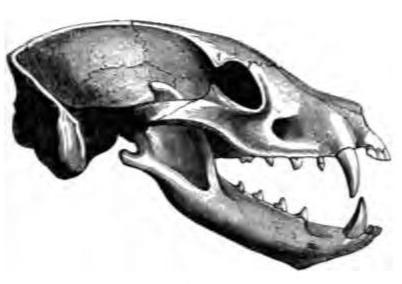|
Aardvark
The aardvark ( ; ''Orycteropus afer'') is a medium-sized, burrowing, nocturnal mammal native to Africa. It is the only living species of the order Tubulidentata, although other prehistoric species and genera of Tubulidentata are known. Unlike most other insectivores, it has a long pig-like snout, which is used to sniff out food. It roams over most of the southern two-thirds of the African continent, avoiding areas that are mainly rocky. A nocturnal feeder, it subsists on ants and termites, which it will dig out of their hills using its sharp claws and powerful legs. It also digs to create burrows in which to live and rear its young. The animal is listed as "least concern" by the IUCN, although its numbers are decreasing. Aardvarks are afrotheres, a clade which also includes elephants, manatees, and hyraxes. Name and taxonomy Name The aardvark is sometimes colloquially called the "African ant bear", "anteater" (not to be confused with the South American anteater), or the "C ... [...More Info...] [...Related Items...] OR: [Wikipedia] [Google] [Baidu] |
Aardvark Skeleton
The aardvark ( ; ''Orycteropus afer'') is a medium-sized, burrowing, nocturnal mammal native to Africa. It is the only living species of the order Tubulidentata, although other prehistoric species and genera of Tubulidentata are known. Unlike most other insectivores, it has a long pig-like snout, which is used to sniff out food. It roams over most of the southern two-thirds of the African continent, avoiding areas that are mainly rocky. A nocturnal feeder, it subsists on ants and termites, which it will dig out of their hills using its sharp claws and powerful legs. It also digs to create burrows in which to live and rear its young. The animal is listed as "least concern" by the IUCN, although its numbers are decreasing. Aardvarks are afrotheres, a clade which also includes elephants, manatees, and hyraxes. Name and taxonomy Name The aardvark is sometimes colloquially called the "African ant bear", "anteater" (not to be confused with the South American anteater), or t ... [...More Info...] [...Related Items...] OR: [Wikipedia] [Google] [Baidu] |
Afrothere
Afrotheria ( from Latin ''Afro-'' "of Africa" + ''theria'' "wild beast") is a clade of mammals, the living members of which belong to groups that are either currently living in Africa or of African origin: golden moles, elephant shrews (also known as sengis), tenrecs, aardvarks, hyraxes, elephants, sea cows, and several extinct clades. Most groups of afrotheres share little or no superficial resemblance, and their similarities have only become known in recent times because of genetics and molecular studies. Many afrothere groups are found mostly or exclusively in Africa, reflecting the fact that Africa was an island continent from the Cretaceous until the early Miocene around 20 million years ago, when Afro-Arabia collided with Eurasia. Because Africa was isolated by water, Laurasian groups of mammals such as insectivores, rodents, lagomorphs, carnivorans and ungulates could not reach Africa for much of the early to mid-Cenozoic. Instead, the niches occupied by those groups o ... [...More Info...] [...Related Items...] OR: [Wikipedia] [Google] [Baidu] |
Tubulidentata
Orycteropodidae is a family of afrotherian mammals. Although there are many fossil species, the only species surviving today is the aardvark, ''Orycteropus afer''. Orycteropodidae is recognized as the only family within the order Tubulidentata (Latin: "tube" (tubulis), "tooth" (dentis)), so the two are effectively synonyms. Evolution The first aardvark fossil discovered was originally named ''Orycteropus gaudryi'' (now '' Amphiorycteropus'') and was found in Turolian deposits on the island of Samos. Since then, representatives of the order Tubulidentata have been located from the Oligocene in what is now Europe, and it is believed that the order probably originated around 65–70 million years ago or in the Paleocene. They are thought to be closely related to the now extinct Ptolemaiida, a lineage of carnivorous afrotheres. The family arose in Africa in the Early Miocene epoch, and spread to Eurasia later in the Miocene. Most of the family's diversity had become extinct by t ... [...More Info...] [...Related Items...] OR: [Wikipedia] [Google] [Baidu] |
Orycteropus
''Orycteropus'' is a genus of mammals in the family Orycteropodidae within Tubulidentata. The genus is known from Late Miocene to recent of Africa. The only living species within Tubulidentata is the aardvark (''Orycteropus afer''). Species Three species are recognized: * '' Orycteropus afer'' – aardvark – Palaeolithic to Recent of Africa * † ''Orycteropus abundulafus'' * † ''Orycteropus crassidens'' – Pleistocene of Kenya * † ''Orycteropus djourabensis'' – Early Pliocene to Early Pleistocene of Chad and Kenya Other species previously assigned to ''Orycteropus'' are now classified in the genus ''Amphiorycteropus ''Amphiorycteropus'' (Latin for "near aadvark") or the wooly aadvark is an extinct genus of mammals in the family Orycteropodidae within Tubulidentata. The genus is known from fossils dating from Middle Miocene to Early Pliocene, found in Afr ...''. References Further reading * Orycteropodidae Mammal genera Mammal genera with ... [...More Info...] [...Related Items...] OR: [Wikipedia] [Google] [Baidu] |
Anteater
Anteater is a common name for the four extant mammal species of the suborder Vermilingua (meaning "worm tongue") commonly known for eating ants and termites. The individual species have other names in English and other languages. Together with the sloths, they are within the order Pilosa. The name "anteater" is also commonly applied to the unrelated aardvark, numbat, echidnas, pangolins, and some members of the Oecobiidae, although they are not closely related to them. Extant species are the giant anteater ''Myrmecophaga tridactyla'', about long including the tail; the silky anteater ''Cyclopes didactylus'', about long; the southern tamandua or collared anteater ''Tamandua tetradactyla'', about long; and the northern tamandua ''Tamandua mexicana'' of similar dimensions. Taxonomy Classification The anteaters are more closely related to the sloths than they are to any other group of mammals. Their next closest relations are armadillos. There are four extant sp ... [...More Info...] [...Related Items...] OR: [Wikipedia] [Google] [Baidu] |
Mammal
Mammals () are a group of vertebrate animals constituting the class (biology), class Mammalia (), characterized by the presence of mammary glands which in Female#Mammalian female, females produce milk for feeding (nursing) their young, a neocortex (a region of the brain), fur or hair, and three ossicles, middle ear bones. These characteristics distinguish them from reptiles (including birds) from which they Genetic divergence, diverged in the Carboniferous, over 300 million years ago. Around 6,400 extant taxon, extant species of mammals have been described divided into 29 Order (biology), orders. The largest Order (biology), orders, in terms of number of species, are the rodents, bats, and Eulipotyphla (hedgehogs, Mole (animal), moles, shrews, and others). The next three are the Primates (including humans, apes, monkeys, and others), the Artiodactyla (cetaceans and even-toed ungulates), and the Carnivora (cats, dogs, pinniped, seals, and others). In terms of cladistic ... [...More Info...] [...Related Items...] OR: [Wikipedia] [Google] [Baidu] |
Insectivore
A robber fly eating a hoverfly An insectivore is a carnivorous animal or plant that eats insects. An alternative term is entomophage, which can also refer to the human practice of eating insects. The first vertebrate insectivores were amphibians. When they evolved 400 million years ago, the first amphibians were piscivores, with numerous sharp conical teeth, much like a modern crocodile. The same tooth arrangement is however also suited for eating animals with exoskeletons, thus the ability to eat insects is an extension of piscivory. At one time, insectivorous mammals were scientifically classified in an order called Insectivora. This order is now abandoned, as not all insectivorous mammals are closely related. Most of the Insectivora taxa have been reclassified; those that have not yet been reclassified and found to be truly related to each other remain in the order Eulipotyphla. Although individually small, insects exist in enormous numbers. Insects make u ... [...More Info...] [...Related Items...] OR: [Wikipedia] [Google] [Baidu] |
Afrikaans
Afrikaans (, ) is a West Germanic language that evolved in the Dutch Cape Colony from the Dutch vernacular of Holland proper (i.e., the Hollandic dialect) used by Dutch, French, and German settlers and their enslaved people. Afrikaans gradually began to develop distinguishing characteristics during the course of the 18th century. Now spoken in South Africa, Namibia and (to a lesser extent) Botswana, Zambia, and Zimbabwe, estimates circa 2010 of the total number of Afrikaans speakers range between 15 and 23 million. Most linguists consider Afrikaans to be a partly creole language. An estimated 90 to 95% of the vocabulary is of Dutch origin with adopted words from other languages including German and the Khoisan languages of Southern Africa. Differences with Dutch include a more analytic-type morphology and grammar, and some pronunciations. There is a large degree of mutual intelligibility between the two languages, especially in written form. About 13.5% of t ... [...More Info...] [...Related Items...] OR: [Wikipedia] [Google] [Baidu] |
Condylarthra
Condylarthra is an informal group – previously considered an order – of extinct placental mammals, known primarily from the Paleocene and Eocene epochs. They are considered early, primitive ungulates. It is now largely considered to be a wastebasket taxon, having served as a dumping ground for classifying ungulates which had not been clearly established as part of either Perissodactyla or Cetartiodactyla, being composed thus of several unrelated lineages. Taxonomic history Condylarthra always was a problematic group. When Condylarthra was first described by , Phenacodontidae was the type and only family therein. , however, raised Condylarthra to an order and included a wide range of diverse placentals with generalized dentitions and postcranial skeletons. More recent researchers (i.e. post-WW2) have been more restrictive; either including only a limited number of taxa, or proposing that the term should be abandoned altogether. Due to their primitive characteristics con ... [...More Info...] [...Related Items...] OR: [Wikipedia] [Google] [Baidu] |




